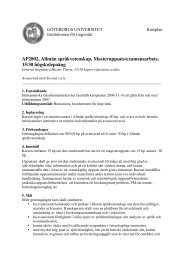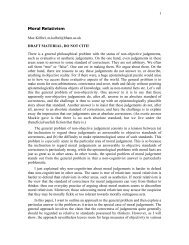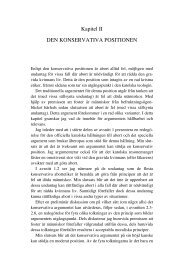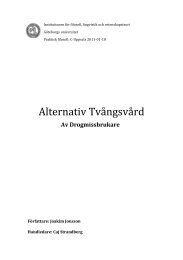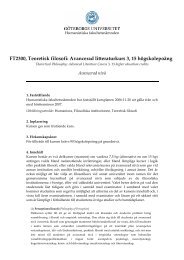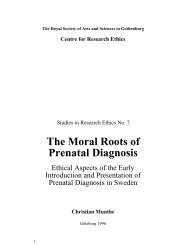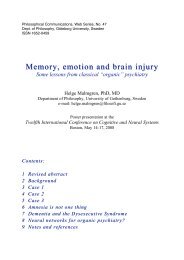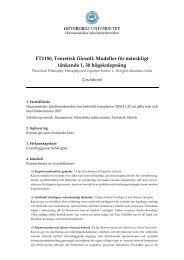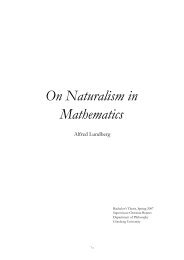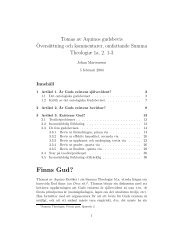Realism, relativism, constructivism, and natural kinds
Realism, relativism, constructivism, and natural kinds
Realism, relativism, constructivism, and natural kinds
You also want an ePaper? Increase the reach of your titles
YUMPU automatically turns print PDFs into web optimized ePapers that Google loves.
1<strong>Realism</strong>, <strong>relativism</strong>, <strong>constructivism</strong>, <strong>and</strong> <strong>natural</strong> <strong>kinds</strong>by Bengt BrüldeAbstractIn the light of the circumstance that there are considerable cultural differences inconceptions of illness, one might ask whether there is such a thing as a single universallyvalid conception of illness. The strong realist thinks so. Or more specifically, heassumes that there is a single correct explanatory theory of what we call illness, <strong>and</strong> heis a diagnostic realist in the sense that he thinks that certain diagnostic categories are<strong>natural</strong>ly given (preferably the ones adopted by modern scientific medicine). This viewhas been challenged by constructivists (or idealists). On the strong anti-realist view,conceptions of illness can only be valid in a local sense, e.g. relative to a certain paradigmor conceptual scheme. A central part of the anti-realist complex is conceptual<strong>constructivism</strong>, i.e. the idea that our actual diagnostic categories are human inventions.However, strong anti-realists also adopt category nominalism (the idea that there are nodiagnostic <strong>natural</strong> <strong>kinds</strong>), as well as the global constructivist idea that reality (qua objectof knowledge), <strong>and</strong> not just our categories, is socially constructed. The latter claim isbased on the assumption that there is no sharp distinction between reality (qua object ofknowledge) <strong>and</strong> our conceptualizations of it, <strong>and</strong> this is what distinguishes the antirealistfrom the weak realist (who thinks that this distinction can be upheld).It is argued that even though the diagnostic realist may be right about certain diagnosticcategories, it seems likely that most of our present diagnostic categories are socialconstructions that do not coincide with any <strong>natural</strong> <strong>kinds</strong>. This suggests that diagnosticnominalism is a rather plausible view. The possible “relativist” implications of thenominalist view are then discussed at length. First, it is argued that if <strong>relativism</strong> isformulated in terms of inconsistent beliefs, it doesn’t get any support from nominalism.However, nominalism might be taken to suggest that there may well be some beliefs thatare true for people in one culture but that are neither true nor false (or evenunintelligible) for people in another culture. Second, it is argued that our objects ofknowledge might not be as sharply distinguished from our conceptualizations of theseobjects as the realist thinks, <strong>and</strong> thus that global <strong>constructivism</strong> may well be moreplausible than weak realism. The reason for this is that it might make less sense than wethink to say that e.g. two different diagnostic categories are alternativeconceptualizations of the same underlying condition. Finally, it is claimed that even ifthere are no diagnostic <strong>natural</strong> <strong>kinds</strong>, this does not in any way imply that allcategorizations are “equally good”. There are other <strong>kinds</strong> of <strong>kinds</strong> besides <strong>natural</strong> <strong>kinds</strong>that can ensure good or useful descriptions, e.g. “discrete <strong>kinds</strong>” <strong>and</strong> “practical <strong>kinds</strong>”.This strongly suggests that the rejection of the <strong>natural</strong> kind view does not imply thatour existing diagnostic categories are arbitrary, <strong>and</strong> thus that nominalism does not haveany “dangerous” relativist implications after all.Key words: conceptual <strong>constructivism</strong>, cultural diversity, diagnostic realism, <strong>natural</strong><strong>kinds</strong>, nominalism, realism, <strong>relativism</strong>, social <strong>constructivism</strong>.
2IntroductionAs medical anthropology <strong>and</strong> the history of medicine have shown us, there are manydifferent conceptions of illness, conceptions that vary a lot between e.g. cultures <strong>and</strong>historical periods. Or more specifically, there are enormous differences with regard to (a)what conditions count as illnesses, i.e. where the line is drawn between the pathological<strong>and</strong> the non-pathological; (b) what diagnostic categories there are, i.e. how the area of thepathological is cut up <strong>and</strong> categorized; (c) how the different illnesses are explained; <strong>and</strong>(d) how the different illnesses identified are believed to be best treated or prevented.In the light of this circumstance, it is worth asking whether there is such a thing as asingle universally valid conception of illness, e.g. whether the modern scientificconception is correct whereas all the alternative conceptions are more or less wrong. Ordoes the existence of cultural diversity, instead, suggest that there are several differentconceptions that are “equally correct”? This general question can be divided into several,more specific, questions, namely: (a) Is there a single correct way to draw the linebetween the pathological <strong>and</strong> the non-pathological? (b) Given a certain demarcation ofthe pathological: Is there a single universally valid set of diagnostic categories, i.e. asingle correct way to cut up <strong>and</strong> categorize the pathological? (c) Given a certaindemarcation of the pathological (<strong>and</strong> a certain set of diagnostic categories?): Is there asingle universally valid explanatory theory of illness? Is there, in each particular case, aunique correct explanation of why certain people happen to suffer from certainillnesses?(a) Assume that A <strong>and</strong> B, two physicians (medicine men, or the like) that belong todifferent cultures, disagree on whether a certain person P is ill or not, <strong>and</strong> that they bothapply the criteria of their own culture correctly. P is deceitful, impulsive, aggressive,reckless, <strong>and</strong> irresponsible, <strong>and</strong> A thinks that he suffers from a mental disorder(Antisocial Personality Disorder), whereas B thinks he is simply a troublesome <strong>and</strong>disturbing character. In cases like this, is one of the parties right while the other iswrong, i.e. do questions of the form “Is P ill or not?” have determinate answers? Or canthey both be right? Does it matter if P belongs to A’s or B’s culture?
3(b) Assume that A (an American physician) <strong>and</strong> B (a Chinese physician) both believethat a certain Chinese woman is ill, but that they disagree on how she should bediagnosed. The patient suffers from sleep, appetite, energy, <strong>and</strong> sexual disturbances, <strong>and</strong>from psychomotor agitation, <strong>and</strong> A thinks that she suffers from Major DepressiveDisorder whereas B thinks she suffers from neurasthenia. Moreover, the fact that onlythe so-called vegetative symptoms of clinical depression are present makes A believethat the affective symptoms (irritability <strong>and</strong> depression) have been suppressed. Orsuppose that 93 percent of the patients that are diagnosed with neurasthenia by B arediagnosed as suffering from various forms of clinical depression by A. (Kleinman &Kleinman 1985, p. 436) Again, we can assume that they both apply the criteria of theirown culture correctly. In cases like this, is at least one of the parties wrong, i.e. is theresuch a thing as a unique best diagnosis? Or can they both be right? And does it matterthat the person diagnosed belongs to B’s culture, e.g. would A be more likely to be rightif the person classified were from A’s culture?One may also ask if it makes any difference whether or not depression exists as adiagnostic category in B’s culture. This question is closely related to the questionwhether it is in order to apply our diagnostic categories to cultures which themselveslack these concepts, e.g. to claim that one percent of the population in ancient Romewere suffering from schizophrenia, or that Socrates suffered from Asperger’s syndrome?(c) Assume that A, B, <strong>and</strong> C disagree on how a certain condition (which we wouldcategorize as an anxiety disorder) should be explained. A explains the condition inneurological terms, B is psychological terms, whereas C thinks that the patient has beeninvaded by a demon or evil spirit. In cases like this, are at least two of the parties wrong,or can two or more of the parties be right? Does it matter to which culture the patientbelongs, e.g. would C be more likely to be right if the person classified were from C’sculture?The strong realist positionA rather common way to respond to these questions is the strong realist position,according to which there is a single correct conception of illness <strong>and</strong> disease, namely theconception embodied by modern scientific Western medicine. There might not be a
4single universally valid demarcation of the pathological, however, since there is little orno reason to believe that the concept of disease (illness, disorder, or malady) is ascientific concept that can be defined in purely factual terms (cf. e.g. Bolton 2000,Brülde 2003, DSM-IV, Culver <strong>and</strong> Gert 1982, Murphy <strong>and</strong> Woolfolk 2000a, 2000b,Nordenfelt 1995, Wakefield 1992, <strong>and</strong> many others). But given such a demarcation, thestrong realist claims that there is a single correct classification, a single correctexplanatory theory, <strong>and</strong> so on.Realists do not just claim that there is a mind-independent reality (a world that existsindependently of our beliefs <strong>and</strong> categories), but also that this world is (in itself)structured in a certain way, that it has a determinate inherent structure that isindependent of our concepts <strong>and</strong> categories. This is normally taken to mean that(R1) there are objective, mind-independent, “brute” facts. The world comes structuredinto facts, i.e. the facts are there, no matter how we represent or describe the world.This metaphysical claim is typically accompanied by the epistemological idea that wecan gain knowledge of these facts, i.e. that we can somehow discover the inherentstructure of reality.Another central realist claim is (R2) the idea that theories or beliefs about the world aretrue to the extent that their content corresponds to the world as it really is. Whether ourbeliefs about the world are true or false depends on the objective facts. This suggeststhat every empirically meaningful statement or belief about the world is either true orfalse (the bivalence principle), <strong>and</strong> that every empirically meaningful question has adeterminate answer.(R1) <strong>and</strong> (R2) jointly imply (R3) that there is a single correct view of the world, i.e. thatthere is a single correct description of reality at each point in time, that there is a singlecorrect explanation of every event, <strong>and</strong> so on. The part of reality that is conceptualizedas pathological is no exception in this regard, e.g. in every particular case of illness, thereis always a unique best explanation of the condition, regardless of how the state isconceptualized, <strong>and</strong> given a certain diagnostic system, there is always a correct
5explanation of why a certain person happens to suffer from a certain illness. 1 Thisimplies that if there is genuine (<strong>and</strong> not merely apparent) disagreement on how a certaincondition should be explained, only one of the parties can be right. It also suggests thatif there is such a thing as radical disagreement in this area (disagreements that are not dueto any cognitive shortcoming, <strong>and</strong> where it is impossible to determine who is right), therealist must concede that there are certain truths that are “epistemically inaccessible”,i.e. that we cannot gain knowledge about.(R3) – the idea that there is a single correct picture of reality – may be interpreted intwo different ways, however, depending on whether or not it is based on theassumption that there is a single correct conceptual system, e.g. a single correctclassification of diseases.The strong realist assumes that “essentialism” is true, i.e. that there are a substantialnumber of <strong>natural</strong> <strong>kinds</strong> “out there”. On the essentialist view of <strong>natural</strong> <strong>kinds</strong>, allmembers of <strong>natural</strong> <strong>kinds</strong> are members by virtue of sharing the same essence, where therelevant essences are normally conceived of as underlying microscopic properties ratherthan as observable properties. Moreover, the underlying essential properties areconceived of as the cause of perceived surface similarities. The essence plays a causalrole in the members’ observable characteristics that is relatively straightforward, direct,<strong>and</strong> necessary. That is, the underlying deep-level structure or essence is associated witha number of observable properties that they explain. These properties are clustered,they occur together. This explains why “[t]he phenomenon of clustering leads to aconfidence in the existence of a deep level essence, even if that essence has not yet beendiscovered” (Khushf 2001, p. 135).If this ”essentialist” view is true, the world itself does not just come structured intofacts, but also into categories, i.e. the world individuates itself to a considerable extent,independently of how we conceive of it. The part of the world that we categorize asillnesses (that fall under the concept of illness, disease, disorder, or malady) is no1 Moreover, certain types of explanations can never be right, regardless of how thepathological is categorized, e.g. people never fall ill because of the evil eye or becausethey have been invaded by demons or evil spirits.
6exception is this regard, e.g. there are discrete illnesses that share the same underlyingessential properties. Let us call this view diagnostic realism.To the extent that essentialism is true (that the world is structured into <strong>natural</strong> <strong>kinds</strong>),we can conclude that there is a single correct way of classifying things, a correctconceptualization of the world. This implies that if there is genuine (<strong>and</strong> not merelyapparent) disagreement on how a certain particular illness should be categorized, e.g.whether a certain condition should be classified as depression or neurasthenia, only oneof the parties can be right. It also suggests that if there is such a thing as radicaldisagreement with regard to classification, the diagnostic realist must concede that theremay well be certain true diagnostic categories that are epistemically inaccessible to us.However, essentialism (diagnostic realism) is typically accompanied by theepistemological idea that it is possible to gain knowledge about this true taxonomy, i.e.to ”carve nature at its joints”, presumably by statistical <strong>and</strong> other scientific methods. Itis, I believe, also commonly believed by diagnostic realists that the present scientificclassification of different disorders is, to a considerable extent, correct. (An essentialistneed not assume that all our present diagnostic categories are <strong>natural</strong> <strong>kinds</strong>, however, e.g.it may well be the case that some “folk illnesses” – diseases that are both culture- <strong>and</strong>time-bound – lack underlying essences.)Now, if the idea that there is a single correct conceptual system is combined with (R3),we get a strong version of this claim, since if there is a single true conceptual system,there is (for this reason) also a view or description of the world that is true or correct ina pretty strong sense. On this strong version of realism, there is a single correctdescription of reality, period, <strong>and</strong> not just in relation to some given conceptual systemor other. The weak realist accepts (R3) but rejects the idea that there is a single trueconceptual system. On this view, there is one correct picture for each conceptualsystem, i.e. given a certain conceptual system, there is always a single correctdescription of the world, a view that is made true by the world itself. (We will return tothis weaker form of realism below.)
7It goes without saying that on the strong (essentialist) version of realism, it is (inprinciple) totally unproblematic to apply a correct diagnostic category to a culturewhich lacks this category. The claim that the incidence rate of diabetes (in our sense ofthe word) was the same in ancient Greece as it is in contemporary Sweden is no moreproblematic than the claim that the air contained as much oxygen, nitrogen <strong>and</strong> hydrogen(in our senses of these words) in ancient Greece as it does in contemporary Sweden. So,is there any reason to believe that it is (on the realist view) more problematic to apply adiagnostic category that is not correct? Suppose that diagnostic categories like ChronicFatigue Syndrome <strong>and</strong> Antisocial Personality Disorder are not part of the correcttaxonomy, i.e. that they do not denote any <strong>natural</strong> <strong>kinds</strong>. Would this make it moreproblematic to say that Socrates suffered from Chronic Fatigue Syndrome than that hesuffered from diabetes? Not really. The important thing is not whether the categoryapplied is true or not, but whether there is a single mind-independent world the natureof which can be sharply distinguished from our conceptualizations <strong>and</strong> descriptions ofthis world. If this distinction can be upheld, it makes perfectly good sense to say thatthe same single world can be conceptualized in radically different ways, <strong>and</strong> that thismind-independent world can function as truth-maker relative to different conceptualsystems (cf. R2 above). For example, given our concept ”burnout syndrome”, it maywell be true that certain people who died long before the concept was introducedsuffered from the syndrome in question, namely if the (present) criteria of applicationwere actually satisfied at the time. That is, there is really no difference between thestrong realist <strong>and</strong> the weak realist in this regard.The strong anti-realist (constructivist) positionThis realist position has been challenged by people from the “anti-realist”(constructivist, or idealist) camp. On the anti-realist view, there is no such thing as auniversally valid conception of illness. Instead, conceptions of illness can only be true orvalid in a local or limited sense, i.e. relative to a certain culture, paradigm, conceptualscheme, linguistic community, or the like.In its global form, social <strong>constructivism</strong> (or idealism) claims that all knowledge <strong>and</strong> allobjects of knowledge are “socially constructed” (cf. e.g. Fleck 1935 <strong>and</strong> Kuhn 1970).These constructivists reject the idea that the world comes structured into facts, <strong>and</strong> that
8we can gain knowledge of these alleged mind-independent facts. On this view, there is nomind-independent world, at least not a mind-independent reality that we can knowanything about (or even form beliefs or theories about). As Hacking (1999) puts it, ”theworld does [on this view] not come quietly wrapped up in facts. Facts are theconsequences of ways in which we represent the world.” (p. 33) Or alternatively put,there is no sharp distinction between the world itself (qua object of knowledge) <strong>and</strong> ourdescriptions of it, which explains the Kuhnian claim that people with differentconceptual systems live in ”different worlds”. The reason for this is that the world (quaobject of knowledge) is a perceived world. And since all perception is taken to includean element of interpretation or conceptualization – since there is no ”bare unmediatedawareness” about the world as it really is (no un-conceptualized “given”, as it were) –this “phenomenal world” (what we observe) is to a large extent determined by theparadigm, language, or culture of the observer. In short, all facts (including scientificfacts) are in some sense institutional as opposed to “brute”, <strong>and</strong> even if there were suchbrute facts, we would not have access to them, i.e. all the structure we can conceive lieswithin our representations of the world (cf. also Kant’s epistemology). That is, truth is(in this particular sense) not fully determined by the world as it is, but also by ourlanguage, categories, or the like.A central <strong>and</strong> rather indispensable part of the anti-realist conception is the idea that ouractual categories (including our concept of illness <strong>and</strong> our diagnostic categories) aresocially constructed, i.e. that they are properly regarded as human inventions orfabrications (category <strong>constructivism</strong>). This is a purely empirical claim that can bedivided into the following three theses:(C1) The negative idea that our actual categories do not denote any <strong>natural</strong> <strong>kinds</strong>, thatthey do not reflect the structure of nature. Or as Hacking puts it, our ”classifications arenot determined by how the world is, but are convenient ways in which to represent it”(ibid., p. 33). For example, our present category of mental disorder is not a “<strong>natural</strong>category” that reflects the structure of the world itself, we have not discovered itthrough careful observation of the world “as it is”. The same thing holds for diagnosticcategories like schizophrenia, diabetes, or Chronic Fatigue Syndrome.
9(C2) Instead, our categories have been “brought into existence or shaped by socialevents, forces, history” (ibid., p. 7), e.g. by psychological, social or economicconditions. The stability of these categories (why they are maintained or kept alive) isexplained in similar terms. For example, it might be argued that our present category ofdisorder is (in part) an outcome of “social <strong>and</strong> political struggles”, or that we need toexplain the category in terms of group interests or doctor-patient interactions. 2If we add the uncontroversial idea that the relevant formative factors could well havebeen different, i.e. that they are contingent, we can also conclude that(C3) our categories are contingent rather than necessary or inevitable. (This is whatHacking (1999) calls contingentism.) For example, categories like tuberculosis, syphilis,or diabetes (which might look “<strong>natural</strong>” or “unavoidable” to some) could well have beendifferent, they are both contingent <strong>and</strong> (in this sense) arbitrary. And in the special caseof science, contingentism claims that “a successful science did not have to develop theway it did” (ibid., p. 32).In short, to be a social constructivist with regard to category X is to believe that ”X neednot have existed, or need not be at all as it is. X, or X as it is at present, is notdetermined by the nature of things; it is not inevitable.” (ibid., p. 6)However, some category constructivists go further than this, <strong>and</strong> make the followingmetaphysical claim (which we can call category nominalism): There are no essences or<strong>natural</strong> <strong>kinds</strong>. There is no single correct conceptual system, no uniquely correct or<strong>natural</strong> way to classify things, to cut up the world. For example, it is not just that ourpresent actual category of illness is a contingent human invention, there is no correct ortrue definition of “illness”, there is no such thing as an objective universally validdistinction between the pathological <strong>and</strong> the non-pathological that can be discovered e.g.by scientific means (this is not how reality is structured). 3 Of course, there is (on this2 Note that (C1) suggests, but does not imply, (C2).3 It is worth noting that category nominalism implies category <strong>constructivism</strong>, but notvice versa: It could be the case that there are <strong>natural</strong> <strong>kinds</strong>, but that these <strong>kinds</strong> are notdenoted by our actual categories. Nominalism does receive some support from<strong>constructivism</strong>, however, since the latter probably is part of the best explanation of theformer.
10view) no such thing as a universally valid nosology either. If there is any such thing asan “objective reality of illness” at all, it is an undifferentiated <strong>and</strong> diffuse reality that canbe conceptualized in many different ways.Category <strong>constructivism</strong> <strong>and</strong> category nominalism are far from sufficient to make astrong anti-realist, however. As we have already seen, a strong anti-realist does not justclaim that our categories (e.g. our diagnostic categories) are socially constructed, but thatour objects of knowledge (e.g. the different illnesses) are constructed as well. As wehave already seen, this claim is based on the assumption that there is no sharpdistinction between reality (qua object of knowledge) <strong>and</strong> our conceptualizations of it. 4There are also other reasons for regarding parts of reality (e.g. social reality) as sociallyconstructed, however, e.g. the fact that certain categories (including a number ofdiagnostic categories) are interactive concepts in Hacking’s (1999) sense, that thesymptoms people get are sometimes (<strong>and</strong> in part) due to the fact that certain diagnosticcategories are available in the culture in which they live. (Think of “burnout syndrome”or “posttraumatic stress disorder”.)The idea that “the same reality” can be conceptualized in different ways, 5 none ofwhich is correct or true, is sometimes taken to suggest that none of theseconceptualizations are better than the others. This has, in turn, been taken to suggestthat we should not apply our categories (including our diagnostic categories) to cultureswhich do not share our conceptual system. For example, we should refrain fromstatements like “N.N. (who lived in the 1890s) was really burnt out” or “Two percentof the Italian population in the 1940s suffered from burnout syndrome”.Another reason that has been given for this cautious attitude is the idea that we can onlyunderst<strong>and</strong> other cultures “from within”, i.e. that our underst<strong>and</strong>ing of these cultures isimpeded if we apply our own categories to what they believe, do, or experience. Thisline of reasoning can easily be applied to the medical practices of different cultures, since4 If a category nominalist would believe that there is an external reality that can bedistinguished from our conceptualizations of it, he would be a weak realist.5 In a constructivist context, we should not take the idea that the same reality can beconceptualized in different ways to mean that there is a single world which constitutes acommon object of knowledge. That is, we have to exercise some caution here.
11we can hardly underst<strong>and</strong> these practices if we do not enter their conceptual scheme.(This type of reasoning can be further amplified if it is combined with a holisticconception of underst<strong>and</strong>ing, according to which nothing can really be understood inisolation from the whole system of which it is a part.) The argument from underst<strong>and</strong>ingcan only be applied to illness to the extent that illnesses are proper objects ofunderst<strong>and</strong>ing, however, i.e. to the extent that they are meaningful or social phenomena,as opposed to e.g. <strong>natural</strong> phenomena. It is worth noting that this argument is closelyrelated to the form of cultural <strong>relativism</strong> which claims that it is somehow immoral tojudge the practices of other cultures, e.g. because every culture has a right to be bothunderstood <strong>and</strong> judged on their own terms (cf. Winch 1958). And the risk of committingthis wrongful act, e.g. to conceive of different medical practices as irrational (accordingto our st<strong>and</strong>ards of rationality, that is), is obviously higher if we apply our owndiagnostic categories to the people who are treated by these practices.However, the most extreme reason why we should not apply our own diagnosticcategories to cultures that lack these categories is given by the type of linguistic idealistwho claims that things do not really exist unless described. Maybe the conditions thatwe tend to identify as burnout syndromes existed before the concept was invented, butthey certainly didn’t exist as burnout syndromes until they were so described. Thissuggests that it is either false or nonsensical to claim that N.N. (who lived in the 1890s)suffered from this syndrome (as opposed to, say, neurasthenia), or that Socratessuffered from autism.It is not quite clear what the strong anti-realist here described would say about question(c) above, e.g. the question of whether there is a unique best explanation of particularillnesses. Suppose that A (a Western physician) <strong>and</strong> B (an African medicine man)disagree on how a certain condition (which A would diagnose as epilepsy) should beexplained. A explains the condition in neurological terms, whereas B thinks that thepatient has been invaded by a demon or evil spirit. In cases like this, would the stronganti-realist perhaps conclude that both parties are right? Or would he conclude that B is
12right if the person classified is from the same African culture? Would he even assumethat demons exist in cultures which believe in their existence? 6Diagnostic nominalism vs. diagnostic realism (essentialism)So, which position is more plausible, strong realism or strong anti-realism? To make thisquestion more manageable, I will first focus on whether it is plausible to assume thatthere are <strong>natural</strong> <strong>kinds</strong> in the part of reality that is covered by our concept of illness(malady, disease, or disorder). Is there any reason to believe that “the world of illness”comes structured into objective categories, e.g. that there are discrete illnesses that sharethe same underlying essences? Is diagnostic realism or category nominalism the moreplausible view?Now, this is a metaphysical question that is rather hard to discuss in any straightforwardway, <strong>and</strong> I will therefore restrict myself to the question whether there is anyreason to believe that our actual diagnostic categories are <strong>natural</strong> <strong>kinds</strong> or socialconstructions. This move is based on the assumption that category nominalism receivesconsiderable support from category <strong>constructivism</strong>, since the latter most probably ispart of the best explanation of the former. 7Let us first note that <strong>constructivism</strong> is clearly a plausible view of our present categoryof illness (malady, or disorder). Consider the case of mental disorder. Our presentcategory of mental disorder does not correspond to any <strong>natural</strong> kind, <strong>and</strong> it has (to aconsiderable degree) been shaped by evaluative considerations. It also seems ratherplausible to assume that nominalism is true in this area. After all, it is highly unlikelythat there is any <strong>natural</strong>ly given category that even remotely coincides with our present6 Cf. Quine’s (1951) idea that conceptual schemes are tools “for predicting futureexperience in the light of past experience”, <strong>and</strong> that physical object are not differentfrom the gods of Homer in this regard. As Quine puts it, “in point of epistemologicalfooting the physical objects <strong>and</strong> the gods differ only in degree <strong>and</strong> not in kind. Both sortsof entities enter our conception only as cultural posits. The myth of physical objects isepistemologically superior to most in that it has proved more efficacious than othermyths as a device for working a manageable structure into the flux of experience.” (p.44)7 Constructivism does not imply nominalism, however, since it could be the case thatthere are <strong>natural</strong> <strong>kinds</strong>, but that these <strong>kinds</strong> are not denoted by our actual categories. (Seenote 3 above. Another reason for believing that category <strong>constructivism</strong> does not givevery strong support to category nominalism is the circumstance that we may discoverthe same <strong>natural</strong> <strong>kinds</strong> in many different ways (cf. argument CC1 below).
13category of mental disorder, which suggests that there is no such thing as a <strong>natural</strong> kindwhich can correctly be labelled “mental disorder”.So, do any of the different conditions that we categorize as diseases or illnesses haveessences, do they denote <strong>natural</strong> <strong>kinds</strong>? To find out which view that is more plausiblehere, diagnostic realism or category <strong>constructivism</strong>, let us look at some arguments can begiven for the different positions.DR1. The perhaps strongest argument that can be given for the diagnostic realist (DR)position is the fact that due to a series of scientific discoveries, there are now a largenumber of diagnostic categories that are defined in pathological (morphological) oretiological terms, e.g. in terms of underlying physiological disturbances or “external”causes (like infectious agents). If it can be assumed that the relevant pathological changesor micro organisms are not just <strong>natural</strong> phenomena but also <strong>natural</strong> <strong>kinds</strong>, this seems toimply that the diagnostic categories that are defined in these terms are <strong>natural</strong> <strong>kinds</strong> aswell. For example, if diabetes mellitus type 1 is morphologically defined as a disturbancein the blood glucose balance caused by a certain kind of deficiency in the beta cells of thepancreas, <strong>and</strong> if the relevant underlying disturbance is a <strong>natural</strong>ly given category, thenthis suggests that the diagnostic category “diabetes mellitus type 1” denotes a <strong>natural</strong>kind too. In a similar way, it can be argued that categories like “malaria”, “tuberculosis”,“cancer”, “syphilis”, <strong>and</strong> “Down’s syndrome” are all names of objectively existingpathological conditions. In short (so the story goes), it seems that the diagnostic realistis right in all those cases where an underlying pathology has been identified <strong>and</strong> turnedinto a defining property.It is doubtful whether this is a good argument, however. First, it can be questionedwhether the relevant underlying pathologies or aetiologies are <strong>natural</strong> <strong>kinds</strong>. But even ifwe (for the sake of the argument) assume that this is the case, it might not follow thatthe diagnostic categories that are defined in terms of these <strong>natural</strong> <strong>kinds</strong> are themselves<strong>natural</strong> <strong>kinds</strong>. The reason for this is that there is (typically) more to an illness or diseasethan the presence of some underlying pathology or aetiology. Consider the case oftuberculosis, which is (by definition) caused by one of several closely relatedmycobacteria. The disease is not identical with the infectious agent, however, e.g. it is
14also required that this entity gives rise to certain typical symptoms. 8 Thiscounterargument has been taken to show that there are no diagnostic <strong>natural</strong> <strong>kinds</strong>, noteven in the cases where discrete <strong>kinds</strong> are caused by a single gene. (Zachar 2000) InZachar’s view, deciding what categories to adopt is not merely a matter of discoveringsome inherent property that underlies all the other properties of the category. However,it is worth noting that this counterargument is based on the assumption that the relevantdefining symptoms are not <strong>natural</strong> <strong>kinds</strong> as well (cf. below).DR2. Many of our present diagnostic categories are not defined in pathological(morphological) or aetiological terms, however, but rather in terms of symptoms. This isdue to the fact that science has not (at least not yet) discovered any underlyingmechanism that makes any morphological or aetiological definition possible. Almost allthe psychiatric categories that can be found in DSM-IV or ICD-10 belong to this“symptomatological” category, <strong>and</strong> the same thing holds for many so-called “stressrelatedillnesses”, like e.g. burnout syndrome, Chronic Fatigue Syndrome, orfibromyalgia. Some of these “symptomatologically based” diagnostic categories areprobably limited to our particular culture, 9 but it is also possible that some of themdenote universal conditions.Not even the most avid realist would claim that all diagnostic categories of this typedenote <strong>natural</strong> <strong>kinds</strong>, however. Consider the case of anti-social personality disorder as itis defined in DSM-IV:There is a pervasive pattern of disregard for <strong>and</strong> violation of the rights of othersoccurring since age 15 years, as indicated by three (or more) of the following: (1)failure to conform to social norms with respect to lawful behaviours as indicatedby repeatedly performing acts that are grounds for arrest; (2) deceitfulness, asindicated by repeated lying, use of aliases, or conning others for personal profit or8 At this point, it is worth noting that microstructure might not be all that matters todetermining the extension of chemical categories like water either. (Cf. Needham 2000,2002.) Needham does not deny that “water” is a <strong>natural</strong> kind term, however, he merelyquestions the rather common idea that all essential properties are microscopic properties.9 In this regard, they are similar to the “folk illnesses” that can be found in differentcultures – like susto (in Latin America), windigo (among Canadian Indians), voodoodeath, or sinking heart (in Punjab) – or in our own past – like nostalgia or neurasthenia.
15pleasure; (3) impulsivity or failure to plan ahead; (4) irritability <strong>and</strong>aggressiveness, as indicated by repeated physical fights or assaults; (5) recklessdisregard for safety of self or others; (6) consistent irresponsibility, as indicatedby repeated failure to sustain consistent work behavior or honor financialobligations; (7) lack of remorse, as indicated by being indifferent to or rationalizinghaving hurt, mistreated, or stolen from another. (DSM-IV, pp. 649-650)This allows for the possibility that two persons are diagnosed as anti-social on entirelydifferent grounds, e.g. that one person satisfies the first three criteria whereas anotherperson satisfies the last three. In the absence of any common underlying pathology, thissuggests that anti-social personality disorder can hardly be regarded as a <strong>natural</strong>ly givencategory. In fact, it is likely that the different members of this category share a familyresemblance, i.e. that they are placed in the category for different reasons. 10However, most diagnostic realists would probably claim that at least somesymptomatologically based categories – e.g. schizophrenia or depression – denote<strong>natural</strong> <strong>kinds</strong>. The strongest argument for this view is that many of the symptoms thatdefine categories of this kind tend to appear in clusters, <strong>and</strong> that this can bedemonstrated with empirical <strong>and</strong> statistical methods. As Khushf (2001) points out (seeabove), “[t]he phenomenon of clustering leads to a confidence in the existence of a deeplevel essence, even if that essence has not yet been discovered” (p. 135).The claim that a certain diagnostic category is a <strong>natural</strong> kind can also get some extrasupport from the circumstance that the condition appears to be universal, <strong>and</strong>/or thatthe percentage of the population that suffer from it is relatively constant over time.Circumstances like these might help establish a condition as a “real disease” (a <strong>natural</strong>rather than social phenomenon), which (in turn) makes it more plausible to regard it as a<strong>natural</strong> kind.10 In this context, it is worth noting that Wittgenstein (1953) introduced the notion offamily resemblances as a part of his criticism against essentialism. In the modern debateit is more common to refer to prototype categories than to family concepts (cf. e.g.Lilienfeld & Marino 1995, 1999). Prototype categories do not just lack necessary <strong>and</strong>sufficient conditions that define membership of the category, they also have fuzzyboundaries.
16So, can the mere existence of a cluster provide support for the idea that the name of thiscluster (or syndrome) is a <strong>natural</strong> kind term? Well, this partly depends on to whatdegree the constituent symptoms appear together, <strong>and</strong> how well the category isdistinguished from other categories. In the case of psychiatric diagnoses, theseconditions are (to put it mildly) not always satisfied to a very high degree. 11Moreover, it is important to note that the constituent symptoms (or rather, thecategories used to describe these symptoms) are often socially constructed, especially inpsychiatry. To see this, consider the different common-sense concepts that are used tocharacterize anti-social personality disorder: “failure to conform to social norms” ishardly a <strong>natural</strong> kind, <strong>and</strong> neither is “deceitfulness”, “impulsivity”, “recklessness”,“irresponsibility”, or “lack of remorse”. The same thing seems to hold for more centralsymptom descriptions like hallucination. 12CC1. So far, the case for category <strong>constructivism</strong> (CC) has been rather defensive. Theconstructivist has merely tried to counter the arguments offered by the diagnostic realist,to show that little or no support can be given for this view. However, there are also afew positive arguments in favour of the constructivist view. The by far most importantline of reasoning that has been offered in favour of <strong>constructivism</strong> is the following one:For many diagnostic categories, we can tell a causal story about how the category inquestion has originated, a story that makes us believe that it has (to a considerableextent) been formed by different <strong>kinds</strong> of social “extra-scientific factors”. In the case ofthe psychiatric categories included in DSM, many entertaining stories of this kind areoffered by Kutchins <strong>and</strong> Kirk (1997). Stories of this kind are also offered aboutmorphologically defined categories, however. The most famous example of this isprobably Fleck’s (1935) story about how the category of syphilis originated. Now,suppose that Fleck’s historical account is correct, i.e. that the category of syphilis has(to a considerable extent) been formed by different <strong>kinds</strong> of “extra-scientific factors”.11 The “validation method” that has been used to decide what diagnoses that should beincluded in or excluded from DSM is entertainingly described in Kutchins & Kirk 1997. Amore technical account is given in Kirk & Kutchins 1992.12 As we have already seen, there is a more general problem here, viz. whether the termsin which the relevant diagnoses are defined are <strong>natural</strong> <strong>kinds</strong>. That is, the question is notjust whether the relevant symptom descriptions include <strong>natural</strong> kind terms, but also
17Does this imply that syphilis is not a <strong>natural</strong> kind, as Fleck himself thinks? The realistmay well dispute this, e.g. by referring to the positivist distinction between contexts ofdiscovery <strong>and</strong> contexts of justification. Or more specifically, he might argue that <strong>natural</strong><strong>kinds</strong> can be discovered in many different ways, <strong>and</strong> that it is far from decisive in whatway a certain category has been arrived at when it comes to determine whether thecategory is a <strong>natural</strong> kind or not. The constructivist counter-move would most probablybe to dispute that the context of discovery can be distinguished from the context ofjustification in the way the realist believes.CC2. Another way in which a constructivist can try to strengthen her position is toargue that at least certain illnesses are more appropriately regarded as socio-culturalphenomena than as <strong>natural</strong> phenomena. For example, if it can be demonstrated thatcertain symptoms or illnesses are “means of communication” or “ways of coping withoverwhelming living conditions” (cf. e.g. Johannisson 1994), then it is rather likely thatthe diagnostic categories that denote these illnesses do not denote any <strong>natural</strong> <strong>kinds</strong>.This argument is based on the assumption that it is far more reasonable to be aconstructivist or idealist (e.g. to claim that there is no sharp distinction between reality<strong>and</strong> our descriptions of it) as far as social reality is concerned. Global constructivists likeKuhn or Fleck seem to think that the <strong>natural</strong> world (qua object of knowledge) is “just asconstructed”, however.To sum up, the diagnostic realist may be right about certain diagnostic categories (e.g.some of the morphologically or aetiologically defined ones), but it seems likely thatmost of our present diagnostic categories are social constructions that do not coincidewith any <strong>natural</strong> <strong>kinds</strong>. So, even though no general conclusion might be possible, itseems that the constructivist is a more plausible position than diagnostic realism, <strong>and</strong>that this gives some support to category nominalism as well.whether the relevant pathological changes (in the case of morphological diagnoses) comein <strong>natural</strong>ly given categories.
18Some further questionsRegardless of whether this conclusion is correct, it is of interest to find out whatimplications the nominalist view has. If we assume that diagnostic nominalism is correct,this gives rise to at least three further questions, namely:(i) What, if any, relativist implications follow from the nominalist view? For example,does category nominalism imply that two inconsistent beliefs can both be true(epistemically flawless, or the like)?(ii) Category nominalism is not compatible with strong realism, but this does not meanthat it implies full-fledged global <strong>constructivism</strong>, since the idea that there is no suchthing as the single most valid diagnostic conceptualization is also consistent with weakrealism. This gives rise to the question which of these two views that is more plausible,weak realism or global <strong>constructivism</strong>. This is really a question of whether or not thereis an (external) “reality of illness” that can be sharply distinguished from ourconceptualizations of this reality. A key issue here is whether it is unproblematic <strong>and</strong>meaningful to say that e.g. two different diagnostic categories are alternativeconceptualizations of the same underlying condition.(iii) If there are no diagnostic <strong>natural</strong> <strong>kinds</strong>, does this in any way imply that all thedifferent conceptualizations of “the world of illness” are equally good (orincommensurable), or can it still be argued that some categorizations are better thanothers? Is it anything we have a reason to worry about, e.g. does category nominalismsuggest that it is arbitrary how “the world” is categorized?Does conceptual nominalism imply <strong>relativism</strong>?According to conceptual nominalism, there is no such thing as a true conceptual system.As we have already seen, this idea does not constitute any fundamental threat to realismas such, since it may well be combined with (R3), in which case we get a weak versionof (R3), viz. the idea that given a certain conceptual system, there is always a singlecorrect description of the world, a view that is (moreover) made true by the world itself.For example, given our concept ”burnout syndrome”, it may well be objectively true
19that certain people who died long before the concept was introduced suffered from thesyndrome in question, viz. if they satisfied the (present) criteria of application.As we have already seen, what makes this weak realist view realist is that “the world asit is” is sharply distinguished from our conceptualizations <strong>and</strong> descriptions of it, <strong>and</strong>that it therefore makes sense to say that the same single world can be conceptualized inradically different ways (<strong>and</strong> that the same single world can function as truth-makerrelative to different conceptual systems; cf. R2 above). If this distinction cannot beupheld, i.e. if the world (qua object of knowledge) is, instead, dependent on ourconceptualizations on it, then this form of realism has to be replaced with a Kuhniantype of idealism, according to which people with (radically) different conceptualsystems live in ”different worlds”. That is, if the nominalist view is not combined with(R1), but with the view that the world (qua object of knowledge) is partly determinedby our conceptualizations of it (<strong>and</strong> that our experience is determined by our concepts,<strong>and</strong> so on), then we get global social <strong>constructivism</strong> (or linguistic idealism).In short, conceptual nominalism implies that either weak realism or idealism(<strong>constructivism</strong> with regard to reality rather than just categories) is correct. So, does anyof these two views have any relativist implications?Both views are of course relativist in a trivial sense, since they both suggest that all truestatements or beliefs are true in relation to some conceptual system or other. As wehave seen, this is something that a realist can accept, at least as long as the world thatdetermines the truth values of our beliefs is mind-independent rather than minddependent(i.e. partly determined by our conceptual system).If we disregard this trivial point, it seems (at least on the face of it) that none of the twoviews has any interesting relativist implications. The reason for this is that <strong>relativism</strong> isalmost always formulated in terms of inconsistency (cf. e.g. Bergström 1990 <strong>and</strong> Wright2001), <strong>and</strong> that none of the two views seems to imply that two inconsistent beliefs canboth be true (epistemically flawless, or the like). Consider the case of idealism (or globalsocial <strong>constructivism</strong>). Idealists like Kuhn <strong>and</strong> Fleck clearly recognize that there isobjective truth given a certain paradigm. Paradigms partly determine (or constitute) the
20world (qua object of knowledge), but within each “world” there is objective truth <strong>and</strong>falsehood. However, this does not in any way imply that the same belief that is true inrelation to one paradigm can be false in relation to another paradigm, or that there aregenuine disagreements where both parties are right. The reason for this is that peoplewho have adopted different paradigms cannot really disagree about the same thing, e.g.since theories that belong to different paradigms are not really about the same world. Inshort, there are no situations where one person P1 believes that p <strong>and</strong> where anotherperson P2 believes that not-p, <strong>and</strong> where both are right (cognitively flawless, or thelike). If P1 <strong>and</strong> P2 belong to the same paradigm, on the one h<strong>and</strong>, then there is objectivetruth, <strong>and</strong> only one of the parties can be right. And if P1 <strong>and</strong> P2 belong to differentparadigms, on the other h<strong>and</strong>, they cannot really have inconsistent beliefs, since thesebeliefs are not really about the same thing (since different paradigms are constituted byincommensurable conceptual systems).To conclude, if the relativist view is formulated in terms of inconsistent beliefs, it cannotfollow from the nominalist idea that there are alternative conceptual frameworks, none ofwhich is more true than the others. But is this all that can be said? I suspect (but it is just asuspicion) that it is not. Doesn’t the nominalist idea that it is (somehow) ”arbitrary” howthe world is conceptualized have any interesting relativistic implications at all? Does itconstitute no threat at all to the realist conception of things?The answer to these questions may of course be “no”, which would (in that case)probably be due to the idea that (radically) different conceptual systems areincommensurable – e.g. that different diagnostic systems cannot translated into eachother, or that it would be impossible to construct a new conceptual system withinwhich different diagnostic systems can be represented or compared – which would (inturn) suggest that genuine disagreements between people with different conceptualsystems are impossible. (In which case this alleged incommensurability should perhapsbe more closely investigated.)But suppose that conceptual nominalism actually has interesting relativisticimplications. In that case, how should this <strong>relativism</strong> be formulated? Here are a few(unsatisfactory?) possibilities: (1) The idea that some beliefs that are true for people in
21one culture are neither true nor false (they might not even be intelligible) for people inanother culture. (This might, by the way, constitute yet another reason why it might beproblematic to apply our categories to foreign cultures.) (2) Can it be fruitful tosomehow appeal or refer to the so-called methodological <strong>relativism</strong> here, or is it a “nonstarter”?On this view, there is no universally valid best method (e.g. culturetranscendentobjective criteria or st<strong>and</strong>ards) that we can use to decide which of twocompeting (inconsistent) theories or interpretations that is most justified.Weak realism vs. reality <strong>constructivism</strong>. The notion of the same underlyingrealityLet us now look at which view is more plausible, weak realism or global <strong>constructivism</strong>.And how do we decide which view is correct? A possible angle here is to focus on thefollowing difference between the two views: To the weak realist, it is unproblematic <strong>and</strong>meaningful to say that e.g. depression <strong>and</strong> neurasthenia are two alternativeconceptualizations of the same underlying objective condition. The constructivist rejectsthis idea, <strong>and</strong> claims instead that reality cannot be sharply distinguished from ourconceptualizations of it in this manner.Consider the circumstance that 93 percent of the Chinese patients that are diagnosedwith neurasthenia by their own physicians are diagnosed as suffering from various formsof clinical depression by American psychiatrists (Kleinman & Kleinman 1985, p. 436).How should we interpret this circumstance, e.g. does it mean that neurasthenia isdepression? On Kleinman <strong>and</strong> Kleinman’s own weak realist view, neurasthenia <strong>and</strong>depression can be understood as “distinctive cultural construals of the samepsychobiological state” (p. 438). That is, they do not just reject the strong realist view(which suggests that depression is underdiagnosed in China), but also the constructivistidea that “the controversy is solely one of opposing cultural construals”. 13 In their ownterms, their own view (weak realism) differs from <strong>constructivism</strong> in that it assumes that“there is some psychobiological reality, some perduring perturbation of human nature,associated with substantial distress that is being labelled differently in the two societies.13 At least, this is what they say. But at the same time, they suggest that the Chinesepatients suppress some of the symptoms of depression, namely the affective ones (seeabove). But isn’t this really to suggest that our category is better, maybe even correct?This sounds like strong realism to me.
22The labels are not creating out of nothing the difficult social reality patients face, thoughthey are organizing that exigent reality in different (sometimes greatly different) ways”(p. 438).What makes this view realist is the assumption that there is some underlying(“unconstructed” <strong>and</strong> mind-independent) “psychobiological reality” that is the same inboth cases, <strong>and</strong> what makes this realist view weak is the assumption that this reality canbe categorized in different ways, none of which can be regarded as the single correctway.Another example of this type of realist reasoning can be found in Nordenfelt & Nyström1986, when they discuss how the meaning of the term “diabetes” has changed fromancient Greece until today. Nordenfelt <strong>and</strong> Nyström point out that the syndromedescribed by Aretaeus more than two thous<strong>and</strong> years ago did not merely have the samename, but that it also reminds us so much of what we think of as symptoms of diabetesthat we tend to regard it as a description of the same disease. However, we have toconsider that diabetes is no longer defined in terms of symptoms, but morphologically,which strongly suggests that a modern physician <strong>and</strong> Aretaeus are not really talkingabout the same thing. So, how do the two concepts differ from each other? OnNordenfelt <strong>and</strong> Nyström’s view, the difference between the modern concept <strong>and</strong> theclassical concept is that the former is more exclusive (narrow) whereas the latter is moreinclusive. To suggest that the extensions of the two concepts can be compared in thissimple manner is exactly the type of realist view that the constructivist would reject. 14Now, it can be argued that this weak realist view is not as plausible as it may seem. Forexample, what kind of state do Kleinman <strong>and</strong> Kleinman have in mind when they suggestthat neurasthenia <strong>and</strong> depression can be understood as different “construals” of thesame “psychobiological state”? There are several possibilities here. It is most likely thatthey have a common set of symptoms in mind, but the alleged neutral state to whichthey refer may also be a common underlying (preferably neurophysiological) pathology.14 In fact, what Nordenfelt <strong>and</strong> Nyström have to say may also be interpreted as a type ofstrong realism, given the additional assumption that we have (due to scientific progress)now discovered the true nature of diabetes, <strong>and</strong> that Aretaeus (due to his ignorance of thetrue underlying pathology) included too much in his category.
23In any case, it is highly unlikely that the “perduring perturbation of human nature” (or“exigent reality”) to which they refer is some kind of unnameable Ding-an-sich (if thiswere the case, we could never know whether neurasthenia <strong>and</strong> depression actually referto the same state). Instead, the underlying reality they have in mind is most probablysomething that can be perceived, named, <strong>and</strong> described, i.e. a possible object ofknowledge. It is doubtful whether this reality can be perceived <strong>and</strong> described in aculturally neutral way, however. In particular, it seems unlikely that there is anyculturally neutral way in which the constituent symptoms can be described, partlybecause the categories used to describe these symptoms are often more or less vaguecommon-sense concepts (like energy <strong>and</strong> sexual disturbances, agitation, or irritability).Moreover, it might be argued that these concepts must be understood in relation to thewhole system of common-sense concepts of which they are parts, which (in turn)suggests that concepts that are embedded in different cultural contexts are (in somesense) incommensurable. 15For example, Johannisson (200x) points out that descriptions of today’s ChronicFatigue Syndrome is strikingly similar to the descriptions given of Neurasthenia ahundred years ago, <strong>and</strong> that this makes many people believe that Chronic FatigueSyndrome is simply a new name for an old condition (i.e. that the two categories areextensionally equivalent, that the two labels denote the same condition). In her ownview, this is not a plausible assumption, however. The two “illnesses” are embedded indifferent historical contexts, <strong>and</strong> the idea that one can find “absolute similarities”between the two conditions is (for this reason) wrong. On this view, diseases are (atleast in some sense) historical phenomena, <strong>and</strong> can (as such) never be reduced tohistorically neutral phenomena, no matter how striking the similarities might seem. Ifthis is correct, it also makes little sense to suggest that modern concept of diabetes ismore inclusive than the classical concept of diabetes.15 Many philosophers (e.g. Winch (1958), Davidson (1974), <strong>and</strong> others) have pointedout that underst<strong>and</strong>ing has a holistic character. For example, we cannot really underst<strong>and</strong>other people’s beliefs or actions (e.g. the beliefs <strong>and</strong> practices of a foreign culture) inisolation, since their meaning is determined by their place of the system of which theyare a part. According to Winch, this circumstance strongly suggests that we cannotmeaningfully say that a certain belief or practice in a certain culture is of the same type asa certain belief or practice in another culture.
24It is worth noting that this issue has rather straight-forward implications for thequestion whether it is in order to apply our categories to foreign cultures or remotehistorical periods. The reason for this is that we can only meaningfully apply ourcategory X to a condition that is categorized as Y in another culture if we can comparethe two categories extensionally, i.e. if X <strong>and</strong> Y are conceptualizations of the sameunderlying reality. 16 This means that if the weak realist is right, it is in principleunproblematic to apply our diagnostic categories to foreign cultures, e.g. it makesperfectly good sense to say that the incidence rate of diabetes was higher in ancientGreece than it is in contemporary Sweden. If the constructivist is right, on the otherh<strong>and</strong>, i.e. if there is no such thing as a common “underlying” reality that can be sharplydistinguished from our conceptualizations of this alleged reality, then it is not really inorder to apply our diagnostic categories other cultures. For example, to apply ourconcept “burnout syndrome” to people who existed long before the concept was firstintroduced has to be regarded as a distortion or misrepresentation of “reality”.Does conceptual nominalism imply that all conceptualizations are “equallygood”?Let us now turn to our final question, namely whether diagnostic nominalism impliesthat it is arbitrary how “the world of illness” is categorized, or whether it still can beargued that some categorizations are better than others.If there are no <strong>natural</strong> <strong>kinds</strong>, there is no such thing as the correct diagnostic system. Thisdoes not imply that our all diagnostic categories are arbitrary, however. An interestingexample of non-<strong>natural</strong> <strong>kinds</strong> that are neither artificial nor arbitrary is what Haslam(2002) calls “discrete <strong>kinds</strong>”. Like <strong>natural</strong> <strong>kinds</strong>, these <strong>kinds</strong> are discrete categories thatreflect objectively discoverable discontinuities in nature, but in contrast with <strong>natural</strong><strong>kinds</strong>, discrete <strong>kinds</strong> are not grounded in defining or causally determining essentialproperties. According to Haslam, melancholia is a good example of a discrete kind inpsychiatry. 1716 But not necessarily the same condition.17 On Haslam’s (2002) view, discrete <strong>kinds</strong> are not the only non-<strong>natural</strong> <strong>kinds</strong> thatdenote <strong>natural</strong>ly occurring discontinuities, there are also what he calls “fuzzy <strong>kinds</strong>”. Incontrast with discrete <strong>kinds</strong>, fuzzy <strong>kinds</strong> do not have sharp boundaries, however. Instead,the latent discontinuity is graded, <strong>and</strong> there are intermediate cases, where it is hard todetermine whether something is category member or non-member. Haslam offers
25Another example of a non-<strong>natural</strong> kind that is not arbitrary (but for a different reason) isthe “practical kind” (cf. Haslam 2002). A “practical kind” is arbitrary in the sense thatthe conceptual boundary does not reflect any objective underlying discontinuities, i.e. itis clearly an artificial type of category. Instead of carving underlying discontinuities,practical <strong>kinds</strong> draw “objectively arbitrary” lines on continua. Moreover, the placementof these conceptual boundaries is (in the case of practical <strong>kinds</strong>) always determined bypractical considerations: a practical kind is defined as a category because of its practicalusefulness. This means that even though practical <strong>kinds</strong> are arbitrary “in principle”,they are not arbitrary “in practice”. According to Haslam, depression is a good exampleof a practical kind in psychiatry. 18To conclude, there are other <strong>kinds</strong> of <strong>kinds</strong> than <strong>natural</strong> <strong>kinds</strong> that can ensure good oruseful descriptions, e.g. there may well be discrete categories that reflect objectivelydiscoverable discontinuities in nature, but which are not based on essences, <strong>and</strong>“practical <strong>kinds</strong>” whose boundaries are drawn on pragmatic grounds are quite common.This strongly suggests the rejection of the <strong>natural</strong> kind view does not imply that ourexisting diagnostic categories are arbitrary, <strong>and</strong> thus that it does not have any“dangerous” relativist implications after all.ReferencesAmerican Psychiatric Association 1994. Diagnostic <strong>and</strong> Statistical Manual of Mental Disorders,4 th edition (DSM-IV). Washington, DC: APA.Bergström L. 1990. Grundbok i värdeteori. Stockholm: Thales.Bolton, D. 2000. Continuing Commentary: Alternatives to Disorder. Philosophy, Psychiatry, <strong>and</strong>Psychology 7(2): 141-153.Borderline Personality as an example of a fuzzy kind in psychiatry. Zachar (2002)questions the idea that fuzzy <strong>and</strong> discrete <strong>kinds</strong> are objective categories that reflect mindindependentdiscontinuities, however. Instead, he suggests that the distinguishing featureof the these categories is that mathematical models can be used to identify theboundaries.18 It is worth noting that this notion of practical kind is more inclusive than the oneadopted by Zachar (2000). According to Zachar, all <strong>kinds</strong> are practical in the sense thatinternal structure alone does not determine category membership, i.e. external orrelational criteria are involved as well. Moreover, all practical <strong>kinds</strong> have at least somepractical utility (reflect human interests, e.g. they enable more or less useful predictions),but they are not necessarily defined as a category because of its practical utility.
26Brülde, B. 2003. The Concept of Mental Disorder. Göteborg: Filosofiska Institutionen.Culver, C. M. <strong>and</strong> Gert, B. 1982. Philosophy in Medicine. Conceptual <strong>and</strong> Ethical Issues inMedicine <strong>and</strong> Psychiatry. Oxford: Oxford University Press.Davidson D. 1974. Psychology as Philosophy. In: Essays on Actions <strong>and</strong> Events. Oxford:Clarendon Press, 1980: 229-239.Fleck L. 1935. Entstehung und Entwicklung einer wissenschaftlichen Tatsache: Einführung in dieLehre vom Denkstil und Denkkollektiv/ Genesis <strong>and</strong> Development of a Scientific Fact.Chicago: University of Chicago Press, 1979.Hacking I 1999. The Social Construction of What? Cambridge, Mass.: Harvard University Press.Haslam N. 2002. Kinds of Kinds: A Conceptual Taxonomy of Psychiatric Categories.Philosophy, Psychiatry, <strong>and</strong> Psychology 9(3): 203-217.ICD-10 (International Statistical Classification of Diseases <strong>and</strong> related Health Problems) 1992-1994. Geneva: WHO.Johannisson K. 1994. Den mörka kontinenten. Stockholm: Norstedts Förlag.##Johannisson K. 200x. Den moderna tröttheten.Khushf G. 2001. What Is at Issue in the Debate about Concepts of Health <strong>and</strong>Disease? Framings the Problem of Demarcation for a Post-Positivist Eraof Medicine. In: Nordenfelt L. (ed.), Health, Science, <strong>and</strong> Ordinary Language. Amsterdam:Rodopi press: 123–169.Kirk S. A. <strong>and</strong> Kutchins H. 1992. The Selling of DSM. The Rhetoric of Science in Psychiatry.New York: Aldine de Gruyter.Kleinman A. <strong>and</strong> Kleinman J. 1985. Somatization: The Interconnections in Chinese Societyamong Culture, Depressive Experiences, <strong>and</strong> the Meanings of Pain. In: Kleinman A. <strong>and</strong> GoodB. (eds.), Culture <strong>and</strong> Depression: Studies in the anthropology <strong>and</strong> cross-cultural psychiatryof affect <strong>and</strong> disorder. Berkeley : Univ. of California Press, 429-490.Kuhn T. S. 1970. The Structure of Scientific Revolutions, 2 nd ed. Chicago: University of ChicagoPress.Kutchins H. <strong>and</strong> Kirk S. A. 1997. Making us Crazy. DSM: The Psychiatric Bible <strong>and</strong> theCreation of Mental Disorders. New York: Free Press.Lilienfeld S.O. <strong>and</strong> Marino L. 1995. Mental Disorder as a Roschian Concept: A Critique ofWakefield’s “Harmful Dysfunction” Analysis. Journal of Abnormal Psychology 104: 411-420.
27Lilienfeld S.O. <strong>and</strong> Marino L. 1999. Essentialism Revisited: Evolutionary Theory <strong>and</strong> theConcept of Mental Disorder. Journal of Abnormal Psychology 108: 400-411.Murphy, D. <strong>and</strong> Woolfolk, R. L. 2000a. The Harmful Dysfunction Analysis of MentalDisorder. Philosophy, Psychiatry, <strong>and</strong> Psychology 7(4): 241-252.Murphy, D. <strong>and</strong> Woolfolk, R. L. 2000b. Conceptual Analysis versus Scientific Underst<strong>and</strong>ing:An Assessment of Wakefield’s Folk Psychiatry. Philosophy, Psychiatry, <strong>and</strong> Psychology7(4): 271-292.Needham P. 2000. What is water? Analysis 60.1, 2000: 13-21.Needham P. 2002. The discovery that water is H 2 O. International Studies in the Philosophy ofScience, Vol. 16, No. 3, 2002: 205-226.Nordenfelt L. <strong>and</strong> Nyström E. 1986. Sjukdomsklassifikation i historisk belysning. In: NordenfeltL. (ed.), Hälsa, sjukdom, dödsorsak: studier i begreppens teori och historia. Malmö: LiberFörlag: 75–105.Nordenfelt, L. 1995. On the Nature of Health. An Action-Theoretic Approach, 2 nd revised edition.Dordrecht: Kluwer.Quine W. V. O. 1951. Two Dogmas of Empiricism. In: From a Logical Point of View. New York:Harper & Row, 1953: 20-46.Wakefield, J. C. 1992. The Concept of Mental Disorder. On the Boundary Between BiologicalFacts <strong>and</strong> Social Values. American Psychologist 47: 373-388.Winch P. 1958. The Idea of a Social Science <strong>and</strong> its Relation to Philosophy. London: Routledge &Kegan Paul.Wittgenstein L. 1953. Philosophische Untersuchungen / Philosophical Investigations. Oxford:Blackwell, 1981.Wright C. 2001. On Being in a Qu<strong>and</strong>ary: Relativism, Vagueness, Logical Revisionism. Mind,110(437): 45-98.Zachar P. 2000. Psychiatric Disorders are not Natural Kinds. Philosophy, Psychiatry, <strong>and</strong>Psychology 7(3): 167-182.Zachar P. 2002. The Practical Kinds Model as a Pragmatist Theory of Classification. Philosophy,Psychiatry, <strong>and</strong> Psychology 9(3): 219-227.



